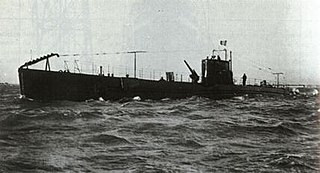
The Brin-class submarine was a group of five long-range submarines built for the Royal Italian Navy during the 1930s.

The R-class or Romolo-class submarine was a group of submarines built for the Royal Italian Navy during World War II. They were designed as blockade running transport submarines for transporting high-value cargo from Europe to Japan and vice versa. Axis-occupied Europe lacked strategic materials such as tungsten, tin and some commodities such as rubber.
The Foca class were a group of three minelaying submarines built for the Regia Marina during the 1930s. All three sister ships played minor roles during the Second World War. One was lost to unknown causes while trying to lay a minefield off British Palestine in 1940, but the other two survived the war to be discarded in 1947.
Comandante Faà di Bruno, also referred to by its shortened name Faà di Bruno, was a Marcello-class submarine built for the Royal Italian Navy in the 1930s. It was sunk in 1940 by British and Canadian destroyers escorting a convoy.
The Italian submarine Acciaio was the name ship of her class of submarines built for the Royal Italian Navy during World War II.

The Argo-class was a class of two coastal submarines built by Cantieri Riuniti dell'Adriatico in Monfalcone for Portugal but operated by the Royal Italian Navy after Portugal was unable to pay construction costs. The submarines were built in 1936, and both served in the Mediterranean Sea at the start of the Second World War. The boats were transferred to the BETASOM Atlantic submarine base at Bordeaux in 1940, but returned to the Mediterranean in 1941, where both were sunk within a few days of the September 1943 Italian armistice.

The Squalo-class submarines were a group of four submarines built for the Royal Italian Navy during the 1930s. They were built at the Cantieri Riuniti dell'Adriatico (CRDA) shipyard at Monfalcone, and designed by Curio Bernardis.

The Argonauta-class submarine was the first sub-class of the 600 Series of coastal submarines built for the Regia Marina during the 1930s. Some of these boats played a minor role in the Spanish Civil War of 1936–1939 supporting the Spanish Nationalists. Of the seven boats built in this class, only a single one survived the Second World War.
Argo was the lead ship of her class of two submarines ordered by the Portuguese government, but taken over and completed for the Regia Marina during the 1930s.
Ametista was the lead ship of her class of a dozen submarines, the second sub-class of the 600 Series of coastal submarines built for the Regia Marina during the early 1930s.
Naiade was one of a dozen Sirena-class submarines, the second sub-class of the 600 Series of coastal submarines built for the Regia Marina during the early 1930s.
Rubino was one of a dozen Sirena-class submarines, the second sub-class of the 600 Series of coastal submarines built for the Regia Marina during the early 1930s.
Smeraldo was one of a dozen Sirena-class submarines, the second sub-class of the 600 Series of coastal submarines built for the Regia Marina during the early 1930s.
Argonauta was the lead ship of her class of seven submarines built for the Regia Marina during the early 1930s.
Jantina was one of seven Argonauta-class submarines built for the Regia Marina during the early 1930s. She played a minor role in the Spanish Civil War of 1936–1939 supporting the Spanish Nationalists, and was later sunk during World War II.
Medusa was one of seven Argonauta-class submarines built for the Regia Marina during the early 1930s.
Goffredo Mameli was the lead ship of her class of four submarines built for the Regia Marina during the 1920s.

Narvalo was one of four Squalo-class submarines built for the Regia Marina during the late 1920s. The boat served in World War II and was sunk in 1943 by British destroyers and aircraft.

Tricheco was one of four Squalo-class submarines built for the Regia Marina during the late 1920s. The boat served in World War II and was sunk in 1942 by the British submarine HMS Upholder.
The Bragadin-class submarines were built for the Regia Marina during the late 1920s. Both boats participated in the Second World War and were discarded in 1948.




